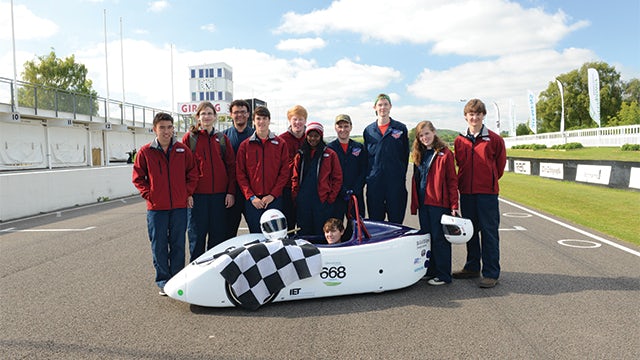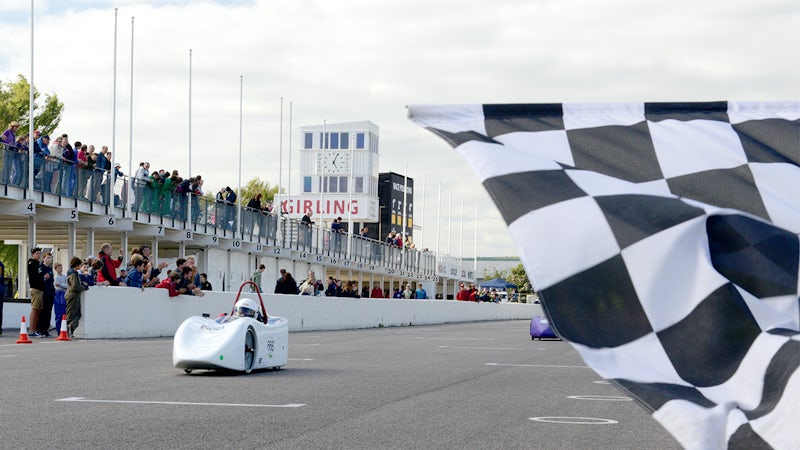Using Solid Edge helps HCT put together a successful run at Greenpower electric car event
Siemens PLM Software enables students to gain valuable engineering experience
The openness of Solid Edge enabled us to import data seamlessly, output it quickly to our 3D printer and share models with others.
Huntsville Center of Technology
Taking the challenge
Huntsville Center of Technology (HCT), a public technology high school in Alabama, has been using Solid Edge® software from Siemens PLM Software in the design and drafting curriculum for over 10 years. When HCT design drafting instructor Mike Evans heard about Greenpower Education Trust’s electric car challenge from the local Solid Edge team, he decided to get his students involved.
Founded in the United Kingdom in 1999, the Greenpower Education Trust is dedicated to inspiring students to study engineering disciplines by making science, technology, engineering and mathematics (STEM) subjects exciting and relevant. The electric car challenge has grown to include more than 600 schools from all over the United Kingdom, culminating in the national finals at Goodwood Motor Circuit in West Sussex, England.
Siemens PLM Software invests in the next generation of engineers by supporting STEM initiatives like Greenpower. Siemens UK is the title sponsor of Greenpower.
Siemens PLM Software saw an opportunity for an industry-academic collaboration. The Solid Edge support staff mentored a group of design students at HCT, helping them build a database out of the Greenpower kit car parts using Solid Edge. Students reverse-engineered the Greenpower kit car components, and that dataset is now offered free of charge to Greenpower schools.

TeamUSA after a full day of racing.
Choosing the right design and materials
No strangers to competitive success, HCT design drafting students have finished first at the state level in Skills USA, and one student was a national winner in 2009. HCT students have excelled in the NASA Great Moonbuggy Race at the United States Space and Rocket Center, and helped design a lunar lander for the Rocket City Space Pioneers’ bid to win the Google XPRIZE.
The Greenpower project of designing and building an electric car proved to be the biggest challenge yet. After seeing how well HCT created the data set of the Greenpower kit car (completed using Solid Edge), the school was invited to take part in the Greenpower Formula 24 and Formula 24+ categories, which concluded with the Greenpower finals in October, 2012. As the only American team invited to take part, the students labeled themselves “Team USA.”
After accepting the opportunity to race, Evans challenged the students to come up with a car body design, and then defend that design to teachers and mentors. Students broke into teams and created prototypes made of various materials. One team produced a small-scale mock up out of Styrofoam and constructed a homemade wind tunnel to show airflow over the car body. Several students spent 17 hours one day in a team member’s basement building a full-scale Styrofoam prototype.
After the initial design was selected, the evaluation of materials began. There were two camps: aluminum or carbon fiber.
“The decision to go with a carbon fiber monochrome was a risky one, but making a different choice wouldn’t have given the students as valuable an experience in design and manufacturing,” says Evans. “It would’ve diminished the educational value to go with an aluminum-framed kit car, and it certainly wouldn’t have looked nearly as impressive on the track.”

Unpacking a precious cargo: the team carefully removes their car from its shipping crate ready for scrutineering.
Overcoming numerous obstacles
Students began their collaboration with Siemens PLM Software and industry experts by modeling their car using Solid Edge and making revisions as they learned about the Greenpower vehicle requirements. One of the most challenging modeling tasks was using the surface commands to create a sleek aerodynamic body shape. The team knew they needed to keep “parasitic form drag” to a minimum while meeting the relevant regulations and accommodating the different body sizes of drivers.
By using the modeling and surfacing capabilities of Solid Edge, they soon had their desired shape, but they still needed to address the low-drag requirements. After the initial model was completed, engineering mentors at NASA (which has a center in Huntsville) took the Solid Edge model and showed students how to test aerodynamic coefficients using computer fluid dynamics (CFD) software.
During this time, the team decided to build two cars; one for practice and one for the race. Although this added time and expense, building the practice car enabled the team to prove every concept before building the race car.
Over the course of the next 17 months, the team faced so many challenges that they weren’t sure if it would ever come together. In fact, after realizing that it was not feasible to be ready for the October 2012 finals, the team set their sights on the June 9, 2013 preliminary qualification race date. The major obstacles included finding a local company with a large enough 5-axis computer numerical control (CNC) machine, securing affordable carbon fiber, finding a company with an autoclave to cure the molds and locating a track to simulate driving at Goodwood Motor Circuit.
During the summer and fall of 2012, students spent countless hours laying plies of carbon fiber over the molds, building re-usable carbon fiber tools to mate with the molds and working with industry professionals to educate themselves on battery and motor performance. Students worked with a local precision engineering shop for the machining of the drive train components.
Solid Edge provides support
“In addition to its modeling capabilities, the true strength of Solid Edge was apparent as we worked with NASA and other industry mentors who used competitor products,” says Evans. “The openness of Solid Edge enabled us to import data seamlessly, output it quickly to our 3D printer and share models with others.”
Mark Piolette, welding instructor at HCT, was brought into the Greenpower collaboration early in the design phase. He is a big fan of multi-disciplined projects because they give his welding students the opportunity to have direct communication with the design and drafting department. Piolette’s second-year precision welding students participated in welding the Greenpower car. Piolette, who previously had little exposure to Solid Edge, saw the benefits of having the car parts designed using Solid Edge output to a 3D printer to create accurate plastic models.
The team used a model created using Solid Edge to produce a steering column with the 3D printer. The welding team was able to analyze and examine the steering column spindles before the weld process began. The welding team was able to give feedback to the design team to get a precise fitment.
“If the steering column was put in without a 3D model, we wouldn’t have been able to get an accurate fitting,” says Piolette.
When machined parts came back, they were not within tolerance, but because of the 3D printed parts, the team was able to take measurements from the 3D models and modify the machined parts. If they only had a drawing to work with, they would have had the dimensions but nothing else.
Learning important lessons
“Even if the students don’t pursue engineering careers, they are gaining invaluable life skills, such as negotiating, compromising and accepting the decisions of others,” says Piolette. “Also, I’ve learned a lot about other departments at the school such as drafting, engineering, and electronics, and that has helped me grow as a teacher.”
Evans also stressed the importance of the students learning about the role that Solid Edge and 3D prototyping played in the success of the car.
“Our car wouldn’t be where it is today without the Solid Edge technology,” says Evans. “We prototyped most all of our parts – including the steering wheel, wheel wells and the battery box – before we had them machined. The students gained valuable insight into prototyping and machining not found in textbooks.”
To finance the project and trip, the student team and school staff developed a sponsorship plan, including securing letters of support from the mayor and the superintendent of the Huntsville schools. Using Solid Edge, the team rendered the concept car with the Team USA logo. This visualization helped inspire support from community leaders.
The Greenpower project enabled students to learn about the integration and teamwork that is required in “the real world” to bring a project from concept to reality. Even the building and construction students made a contribution; after designing the shipping crate using Solid Edge, the students built a crate to hold the car, batteries and equipment.
Finishing strong
The HCT students traveled to England to race in the preliminary trials at Goodwood in June, 2013. Although the team had never competed in any Greenpower race, the HCT’s Team USA, competing with university level students, placed 7th out of 14 in the 90-minute Formula 24+ race, and 13th out of 54 in the Formula 24 race, qualifying this first-time team for the national finals at Goodwood in October of 2013.
“Team USA did a fantastic job,” says Jeremy Way, chief executive officer (CEO) of Greenpower Education Trust. “To finish five-and-a-half hours of racing without any breakdowns, and qualify for the UK National Finals on their very first attempt, is really amazing. Very few teams in the UK have managed to achieve that.”
Greenpower provided HCT with a multidisciplinary, collaborative STEM project. With this kind of experience, HCT believes that their students have a head start in gaining the industry knowledge and experience that they need to become the innovators and technical leaders of tomorrow.
In addition to its modeling capabilities, the true strength of Solid Edge was apparent as we worked with NASA and other industry mentors who used competitor products. The openness of Solid Edge enabled us to import data seamlessly, output it quickly to our 3D printer and share models with others
Huntsville Center of Technology
